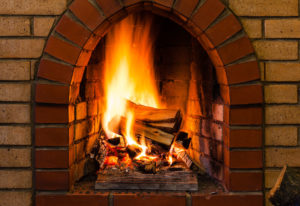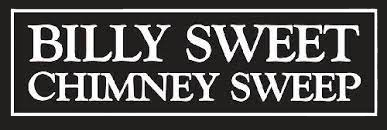During the season of fuel and fires, ventilation and maintenance, it’s important to not cut corners. Cutting corners when it comes to your fireplace and chimney can result in serious damage to your home, costly services to your chimney system, and even injury and possible loss of life. In order for your chimney to work safely and efficiently all winter long and year after year, it must be maintained properly and used correctly. The National Fire Protection Association (NFPA) and the Chimney Safety Institute of America (CSIA) help to keep fire in its place by educating responsible homeowners to schedule routine chimney sweeps and annual chimney inspections. This ensures the safest and most efficient systems.
The Danger of Dirty Chimneys
 When a fire burns in your fireplace it constantly produces soot and creosote and deposits them into the chimney flue. Soot is merely carbon, harmless unless it’s allowed to buildup and cause an obstruction. Creosote is produced when organic materials are burned and is made up mostly of tar, a sticky, flammable substance. It builds upon itself until a significant buildup occurs, slowing the flow of air through the flue. As efficiency drops, the buildup worsens and hot air begins to stall in the system. As temperatures increase, the creosote boils and the water evaporates leaving a concentrated, hardened mass when the creosote cools. This buildup called “glazed creosote” is highly flammable, obstructs airflow, and is difficult to remove. Because of this, creosote should be removed before it reaches 1/8 inch in thickness. A standard chimney sweep can remove creosote, but glazed creosote requires a special industrial solvent that transforms the creosote as it’s absorbed.
When a fire burns in your fireplace it constantly produces soot and creosote and deposits them into the chimney flue. Soot is merely carbon, harmless unless it’s allowed to buildup and cause an obstruction. Creosote is produced when organic materials are burned and is made up mostly of tar, a sticky, flammable substance. It builds upon itself until a significant buildup occurs, slowing the flow of air through the flue. As efficiency drops, the buildup worsens and hot air begins to stall in the system. As temperatures increase, the creosote boils and the water evaporates leaving a concentrated, hardened mass when the creosote cools. This buildup called “glazed creosote” is highly flammable, obstructs airflow, and is difficult to remove. Because of this, creosote should be removed before it reaches 1/8 inch in thickness. A standard chimney sweep can remove creosote, but glazed creosote requires a special industrial solvent that transforms the creosote as it’s absorbed.
Creosote buildup is not the only danger of a dirty chimney. If your chimney isn’t cleaned on a regular basis the creosote and soot can hide liner damage, allowing the heat to transfer through the masonry and onto the other building materials of the home. This can create a serious fire hazard. Additionally, without a routine sweep, you might have accumulated any number of things in your flue or fireplace. Animals, sticks and leaves, and unburned wood are all things that we find in neglected chimney systems—all contributing to unwelcome odors and ventilation problems.
The Importance of Inspections
It’s so important to have your chimney inspected as well as cleaned that most chimney companies include a basic level one inspection with every cleaning! An inspection will ensure that the system is safe and efficient for another year of use. However, who completes the inspection is vital. Only a certified chimney sweep should inspect your chimney system. An amateur won’t know where to look and a homeowner won’t recognize the signs of a problem until it’s too late. Every chimney should undergo a CSIA inspection annually. This is a complete diagnostic assessment of the chimney from top to bottom. Billy Sweet Chimney Sweep offers level one, two, and three CSIA inspections for homeowners in and around Boston, North Shore, and Portland. Not only do we inspect every chimney that we sweep, but we sweep every chimney we inspect.
If your chimney system hasn’t changed or shown any problems in the last year, our technician will complete a level one inspection. This is an inspection of all the readily accessible portions of the system. The video scan is usually only available for a level two inspection, but we check every chimney with video surveillance. We use a Chim-Scan camera system and Wohler Vis2000-Pro for an inside look at the flue.
A level two inspection is necessary in the following conditions; if there have been changes made to the chimney system, if it’s presented problems, and before the sale or transfer of the property. It includes everything from a level one inspection as well as everything accessible through doors and passageways.
A level three inspection is only necessary when a serious hazard is suspected, but at this point, it is the only thing to get your system up and going again.
Common Chimney Dangers
Besides creosote buildup, there are numerous problems that can arise when a chimney isn’t properly cleaned and maintained. At Billy Sweet Chimney Sweep we diagnose winter damage most often—masonry damage that results in a serious drop in efficiency and rise in fire risk. Another common hazard that we see quite often is a damaged firebox. The firebox is the space that holds the fire. It endures the highest temperatures for the longest amounts of time but gets very little attention. Though many focus only on flue fires, the fire hazard associated with a damaged firebox may be the most serious. Prolonged heat exposure through damaged firebricks can cause structural damage as support beams become brittle with heat damage. A similar danger can arise when the liner is damaged and heat transfers through the masonry. Insulation in walls and attics can ignite as heat moves from the chimney into the home.
As with most residential fires, chimney and fireplace fires can be prevented. It is our goal to help our customers, friends, and neighbors in our service area to stay safer and warmer this winter by offering services that prevent fires.
Schedule your services now by calling 617-469-4528 or schedule an appointment online today.
